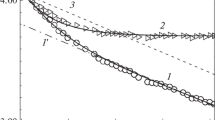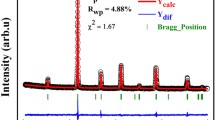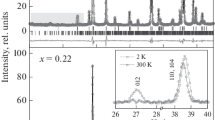Abstract
The nature of the training effect in exchange-biased compounds is studied. This effect consists in a decrease in the exchange bias field (HEB) during a cyclic change in the magnetic field. The electrical resistivity training effects in the GdBaCo2O5 + δ (δ ≈ 0.5) cobaltite, namely, the changes in the electrical resistivity during a cyclic change in the magnetic field (ρcycl(N), N is the cycle number) and during sample rotation (ρrot(N)), are shown to be analogs of the HEB training effect. Like HEB, the electrical resistivity changes sharply after the first cycle (N > 1(2)) and slowly during the next cycles, which is related to a decrease in the magnetization of ferromagnetic particles. These results are explained by the influence of two mechanisms: the magnetization decreases fast in the first mechanism and slowly in the second. The nonequilibrium state and the training effect are assumed to be interrelated and caused by the existence of single-domain ferromagnetic particles of different volumes V and by the dependence of the magnetization relaxation time of the particles on the single-domain (superparamagnetic) particle volume, τ ∝ exp(KanV/kT), where Kan is the magnetic anisotropy energy density. The nature of the sharp changes in HEB and the electrical resistivity after the first cycles is caused by the closeness of the small single-domain particle energy (KanV) to heat energy kT. In this model, the exchange bias disappears (HEB = 0) during infinite cyclic magnetization reversal.








Similar content being viewed by others
REFERENCES
W. H. Meiklejohn and C. P. Bean, Phys. Rev. 102, 1413 (1956).
W. H. Meiklejohn and C. P. Bean, Phys. Rev. 105, 904 (1957).
A. E. Berkowitz and K. Takano, J. Magn. Magn. Mater. 200, 552 (1999).
J. Nogues and I. K. Schuller, J. Magn. Magn. Mater. 192, 203 (1999).
R. L. Stamps, J. Phys. D 33, R247 (2000).
M. Kiwi, J. Magn. Magn. Mater. 234, 584 (2001).
F. Radu and H. Zabel, Springer Tracts Mod. Phys. 227, 97 (2008).
K. Giri and T. K. Nath, J. Nanosci. Nanotechnol. 14, 1209 (2014).
C. Binek, Phys. Rev. B 70, 014421 (2004).
A. Hochstrat, Ch. Binek, and W. Kleemann, Phys. Rev. B 65, 092409 (2002).
A. Hoffmann, Phys. Rev. Lett. 93, 097203 (2004).
P. Miltényi, M. Gierlings, J. Keller, et al., Phys. Rev. Lett. 84, 4224 (2000).
A. P. Malozemoff, Phys. Rev. B 37, 7673 (1988);
J. Appl. Phys. 63, 3874 (1988).
D. Paccard, C. Schlenker, O. Massenet, et al., Phys. Status Solidi B 16, 301 (1966).
N. I. Solin, S. V. Naumov, and S. V. Telegin, J. Exp. Theor. Phys. 128, 281 (2019).
K. B. Vlasov, N. V. Volkenshtein, S. V. Vonsovskii, et al., Izv. Akad. Nauk SSSR, Ser. Fiz. 28, 423 (1964).
N. I. Solin, S. V. Naumov, S. V. Telegin, and A. V. Korolev, JETP Lett. 104, 49 (2016).
L. Neel, Rev. Mod. Phys. 25, 293 (1953);
Ann. Geophys. 5, 99 (1949).
A. Maignan, C. Martin, D. Pelloquin, et al., J. Solid State Chem. 142, 247 (1999).
A. A. Taskin, A. N. Lavrov, and Y. Ando, Phys. Rev. B 71, 134414 (2005).
M. P. Pechini, US Patent No. 3330697 (1967).
N. I. Solin, S. V. Naumov, S. V. Telegin, and A. V. Korolev, J. Exp. Theor. Phys. 125, 1096 (2017).
M. Patra, S. Majumdar, and S. Giri, J. Phys.: Condens. Matter 21, 486003 (2009).
M. Patra, S. Majumdar, and S. Giri, Eur. Phys. Lett. 87, 58002 (2009).
B. H. Miller and E. Dan Dahlberg, Appl. Phys. Lett. 69, 393216 (1996).
C. Leighton, M. Song, J. Nogués, et al., J. Appl. Phys. 88, 344 (2000).
H. Fulara, S. Chaudhary, and S. C. Kashyap, Appl. Phys. Lett. 101, 142408 (2012).
N. I. Solin, S. V. Naumov, and V. A. Kazantsev, J. Exp. Theor. Phys. 130, 690 (2020).
D. Niebieskikwiat and M. B. Salamon, Phys. Rev. B 72, 174422 (2005).
C. P. Bean, J. Appl. Phys. 26, 1381 (1955).
J. S. Kouvel, J. Phys. Chem. Solids 16, 107 (1960).
W. H. Meiklejohn, J. Appl. Phys. 33, 1328 (1962).
A. K. Zvezdin and K. A. Zvezdin, Priroda, No. 9, 8 (2001).
ACKNOWLEDGMENTS
We thank A.V. Korolev for performing the magnetic measurements.
Funding
This work was performed in terms of a state assignment of the Federal Agency of Scientific Organizations (project Spin no. AAAA-A18-118020290104-2) and was supported in part by the Russian Foundation for Basic Research (project no. 20-02-00461).
Author information
Authors and Affiliations
Corresponding author
Additional information
Translated by K. Shakhlevich
Rights and permissions
About this article
Cite this article
Solin, N.I., Naumov, S.V. Electrical Resistivity Training Effect in the Exchange-Biased GdBaCo2O5.5 Cobaltite. J. Exp. Theor. Phys. 132, 264–276 (2021). https://doi.org/10.1134/S1063776121020084
Received:
Revised:
Accepted:
Published:
Issue Date:
DOI: https://doi.org/10.1134/S1063776121020084




